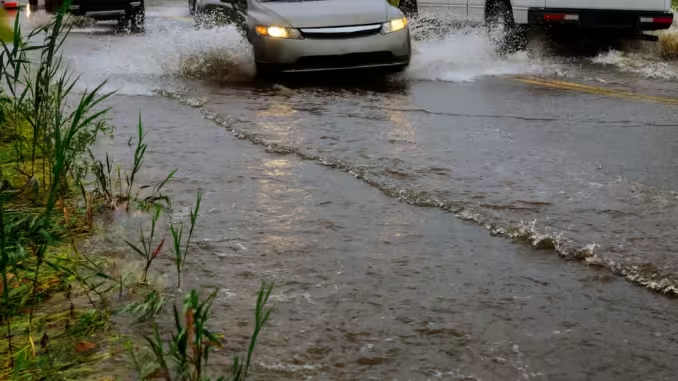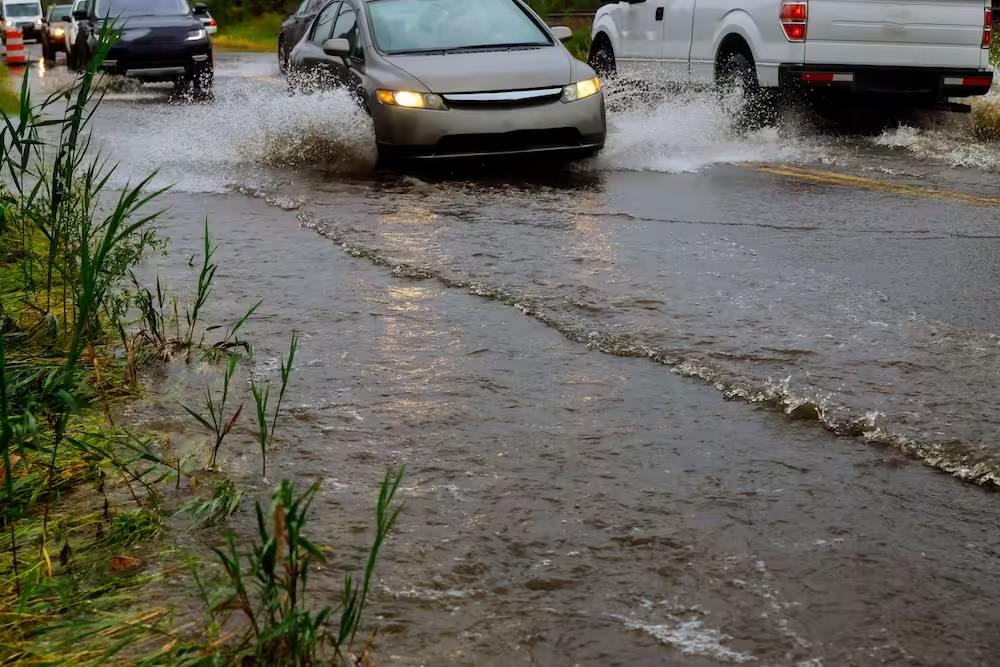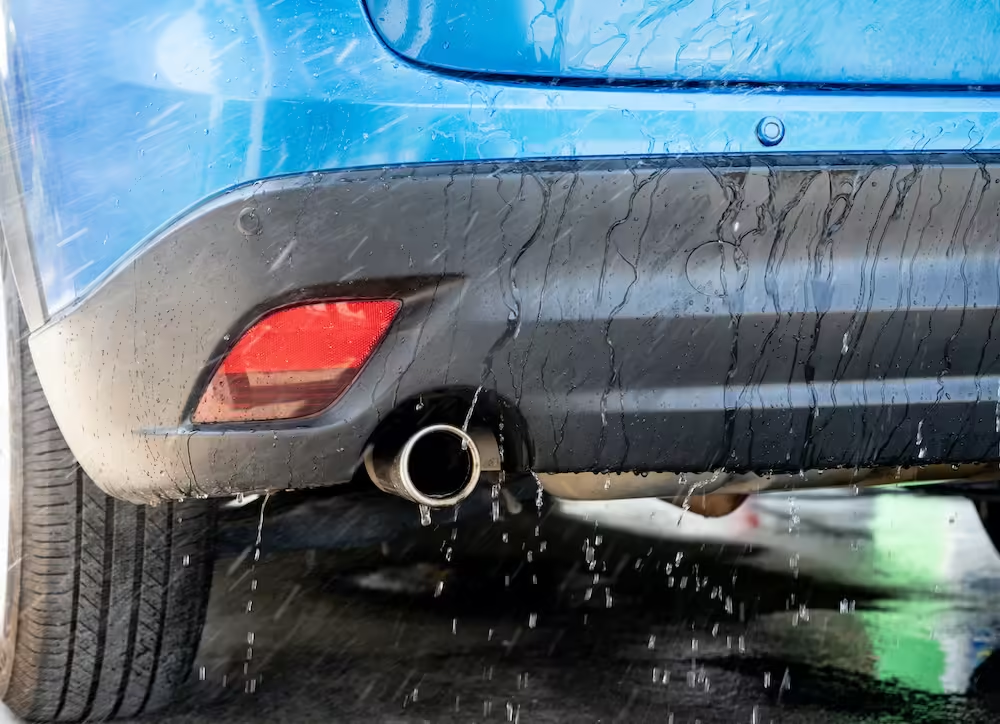
With the growing popularity of electric vehicles (EVs), many drivers are asking critical questions about their performance in adverse conditions. One common concern is how EVs handle heavy rain and flooded roads. Traditional gasoline cars can face serious challenges in such conditions, but what about electric vehicles? Are they more vulnerable due to their electric components? This blog post will explore how EVs perform in heavy rain and flooded roads, and what precautions you should take when considering driving through water.

1. Understanding EV Technology: Water Resistance in Electric Vehicles
Electric vehicles are often perceived as delicate when it comes to water exposure due to their reliance on high-voltage systems and battery packs. However, modern EVs are engineered with sophisticated waterproofing and sealing technologies to withstand typical wet conditions, including rain and even light flooding.
Waterproofing and Sealing:
Most electric cars have been designed with water-resistant materials and engineering techniques to protect the battery, motor, and other electrical components. The battery pack, which is usually located at the bottom of the vehicle, is sealed and waterproofed to prevent moisture from entering. This sealing ensures that the battery can handle wet conditions, making EVs quite resilient during rainstorms.
Manufacturers put EVs through rigorous testing, including simulated heavy rain and shallow water immersion, to ensure safety and reliability. As a result, electric cars are just as capable, if not more, of driving in rain than traditional internal combustion engine (ICE) vehicles, which can suffer from engine stalls if water enters the air intake.
2. Driving an EV in Heavy Rain: What to Keep in Mind
Driving through heavy rain is generally safe for EVs, but there are a few considerations that you should keep in mind to ensure a smooth and safe experience:
Traction Control and Stability:
EVs typically have excellent traction control systems, which helps improve stability on wet or slippery roads. The electric motor provides instant torque to the wheels, which is beneficial for controlling acceleration and avoiding wheel spin. However, drivers should always exercise caution on wet roads, as hydroplaning is a risk for any vehicle.
Brake Performance in Wet Conditions:
EVs often come equipped with regenerative braking systems that recover energy as the car slows down. In rainy conditions, these systems function normally, but drivers should be cautious when applying traditional brakes. Wet roads can reduce braking efficiency, so make sure to leave extra space between your vehicle and the car in front.
Battery Performance in Cold and Wet Weather:
While rain itself does not directly affect the battery’s performance, colder temperatures that often accompany rainy weather can lead to reduced range. Cold weather can decrease the efficiency of the battery, so be mindful of your available range during long rainy drives. Preconditioning your EV, or warming the battery before driving, can mitigate this effect.
3. Flooded Roads: Can EVs Handle Deep Water?
While EVs are well-equipped to handle rain, flooded roads present a different challenge. Here’s what you need to consider:
Ground Clearance:
One of the most important factors when driving through flooded areas is the ground clearance of your vehicle. Ground clearance refers to the height between the base of your car and the road. If water rises above this level, it can lead to water entering parts of the car where it shouldn’t, potentially damaging the electrical system. Most EVs have a similar ground clearance to ICE vehicles, so the general rule is to avoid driving through water deeper than half the height of your wheels.

Water Depth Warnings:
Some EV manufacturers, like Tesla, include built-in water detection systems that alert drivers when water levels are too high for safe driving. These sensors are designed to protect the electrical systems from being compromised in flooded conditions.
Risk of Damage to Electrical Components:
Despite their waterproofing, deep water exposure can still pose risks. Prolonged submersion or exposure to very high water levels can damage the battery, wiring, and other electrical systems. EVs are designed with multiple layers of insulation and protection, but nothing is fully submersion-proof.
Regenerative Braking and Water:
When driving through water, the regenerative braking system should not be adversely affected. However, water can reduce the effectiveness of your traditional friction brakes, so after crossing a flooded area, it’s a good idea to test the brakes to ensure they’re working correctly.
4. Key Precautions for Driving an EV Through Water
Driving any vehicle through deep water can be dangerous, but for EV drivers, extra care is essential. Here are the key precautions to consider before navigating through waterlogged areas:
Check Water Depth:
As mentioned, never drive through water that is higher than half the height of your wheels. A good rule of thumb is that if you can’t see the road surface or if the water level appears higher than the midpoint of your tires, turn around and find another route. If you attempt to cross deep water, there’s a risk of the vehicle becoming stuck, or worse, the water could enter the cabin and damage internal components.
Avoid Standing Water:
It’s not just the depth of the water that matters—standing water on roads can hide potholes, debris, or deeper sections that could pose a threat to your vehicle. Drive slowly and carefully through any standing water to avoid damaging your EV’s tires or suspension.
Pay Attention to Alerts:
Many modern EVs are equipped with onboard computers that monitor the status of the car in real time. These systems can alert you to potential issues like water ingress or problems with the electrical systems. Pay close attention to any warning lights or messages on your dashboard when driving in wet conditions.
Test Your Brakes After Driving Through Water:
After driving through a flooded section of road, take a moment to test your brakes. Lightly apply the brakes to ensure they are responsive and functioning properly. Water can sometimes reduce the effectiveness of the braking system, and you don’t want to find this out during an emergency.
5. What Happens If Your EV Gets Stuck in Water?
If your EV becomes stuck in water, treat the situation as you would with any vehicle. The first priority is safety—don’t attempt to restart the car if it has stalled in water. This could cause more damage to the electrical systems. Instead, safely exit the vehicle if possible and call for roadside assistance. Most EV manufacturers and insurance policies offer coverage for water-related incidents, so you may be protected in case of water damage.
6. Insurance and Warranty Considerations
Before attempting to drive your EV through flooded areas, it’s important to understand your insurance and warranty coverage. Many insurance policies cover water damage, but some may have specific limitations. Check your policy to ensure that you’re protected against water damage or flooding, as repairs can be costly if your EV is damaged by deep water.
Additionally, consult your EV manufacturer’s warranty for coverage details. Many warranties cover defects in waterproofing and electrical components, but damage caused by negligence—such as driving through deep water—may not be covered.
Conclusion: Safe Driving in Rain and Waterlogged Roads
Electric vehicles are fully capable of driving in heavy rain, and they often outperform traditional cars in wet conditions due to their advanced traction control and waterproofing. However, like any vehicle, EVs are not invulnerable to the risks posed by deep or standing water. By exercising caution, understanding the limits of your vehicle, and paying attention to water depth, you can navigate rainy and flooded conditions safely in your electric car.
When in doubt, avoid driving through water that seems too deep, and always prioritize safety over speed. EV technology is advancing rapidly, and these cars are built to be durable, but like any vehicle, they have their limits when it comes to extreme weather conditions.

Leave a Reply